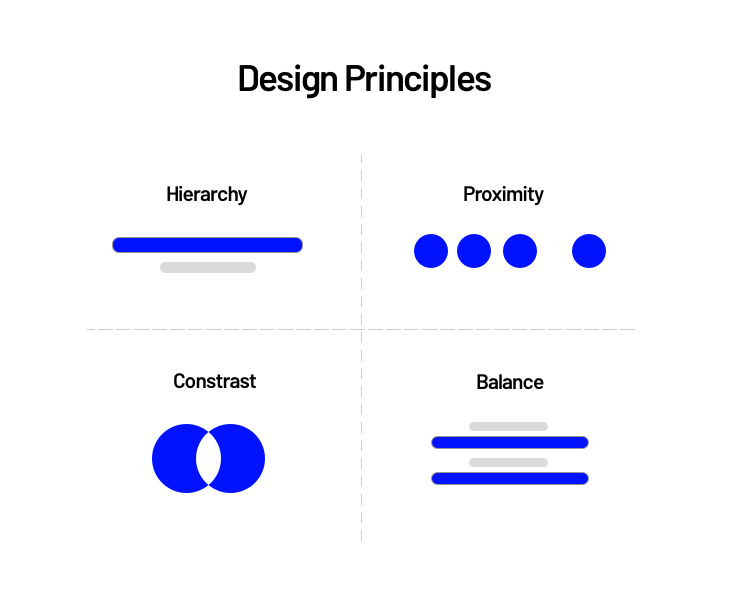Whether you’re a designer or not, there’s some great advice that can be taken away from design principles. Even if you work in marketing or sales or project management, you should be aware of how your customers perceive your communications. Because focusing on the user is the key to success.
Visual Principles
When it comes to design, there’s two main “focus groups” – UI and UX. UI (or User Interface) focuses more on the visual side of things, while UX (User Experience) focuses on usability and experience. So, the principles can also be divided into those two groups. The visual ones are more about how things look and how to emphasise the most important information. Those guidelines can be used when making something customer-related but you can also use them when preparing reports or presentations.
1. Prioritizing & Emphasising Information
A good design will instantly convey the right message. And that’s because designers know that information should have hierarchy. You need to think about the key piece of information that should be taken away from your presentation, speech etc. There’s several methods you can use to achieve this goal. You can play with alignment – asymmetrical messages will stand out more than symmetrical ones. You can also use colour and sizing to attract attention. Just remember – always prioritize information!
2. White Space
White space isn’t just a blank space. It’s an important part of the message because it organizes the communication. Just like leaving a pause between sentences will help you be understood better, the white space enables your audience to clearly get your message without any distractions. More isn’t always better.
3. Sections & Proportion
It’s rare that only one piece of information is important in a certain message. Usually, you will find that multiple aspects are all crucial. That’s when you should use sections and different proportions. It will help the audience see the message as different sections, each equally important, and not as a single piece.
Usability Principles
What’s more interesting for many people are the usability principles. Design is about much more than just a nice look. When creating products, communications etc., you need to consider how your audience perceives certain things. Their habits, expectations and thought processes are very important when you’re looking to reach them.
1. Keep Users Informed
When there’s any status information involved, the user should be kept in the loop at all times. They will feel safer when they are aware of what’s going on. That’s why you can see the call or screen recording sign on the status bar on your phone. The same goes for cellular data and the service bars. You should provide constant feedback.
2. Don’t Force Users To Remember Information
Users shouldn’t need to remember anything. They should have easy access to all the important information, and the most important pieces should be visible at all times to provide comfort and peace of mind. Different options and buttons should be visible.
3. Stick To What The Users Know
When creating something, a new creative for your campaign or a presentation, don’t try to reinvent the wheel. It’s perfectly fine as is. People are more positive towards the things they already know. Uncertainty is a conversion killer. Always think about the users’ habits and previous experiences.
4. Don’t Distract The User
While adding some special effects may seem tempting, it’s not always the best choice. You should always keep in mind that some of those elements might be a distraction. And that’s not something you want. Never interrupt the user and reduce any distractions that might prevent them from completing a task. That’s especially important when it comes to their purchasing decisions and order-placing.
Whether you’re a project manager, a marketer or a developer – those principles are something to always keep in mind. The user should be at the centre of everything you do, because that’s how you will achieve success. If you’re looking for a team who knows all about those principles and creates excellent products according to them – contact us for a free product consultation!

